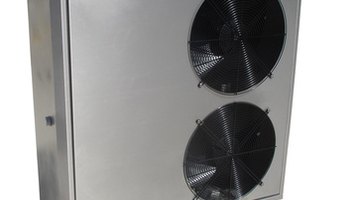How to Troubleshoot an Air Handler Float Switch
Water dripping through the ceiling and an air handler sitting in a drain pan full of water directly above it is more common than you think, says Christian Smith, an HVAC contractor.

Things You Will Need
- Cup
- Bucket
The float switch, a safety device that shuts the system down when condensation overflows into the drain pan, can fail for a number of reasons, according to Smith. The good news is that it can be troubleshooted. Many homeowner insurance policies cover the damage to your ceiling.
-
Turn off the HVAC system using the circuit breaker.
-
Drain the water out of the drain pan. Use a bucket and cup for scooping the water out if the pan does not have a drain valve.
-
Locate the float switch and verify it is mounted in the drain pan. Typically, the switch is located on the same side as the air handler's access doors and is attached to the side of the pan. The switch can become dislodged if accidentally bumped.
-
Check the movement of the float arm on the float switch. It is a small metal arm protruding out of the main body of the switch with a piece of foam attached to the end. The arm connection inside the switch is delicate and sometimes binds during installation. The mechanical section of the switch is defective if the arm does not lift easily and makes a light clicking noise when it nears the top of the switch.
-
Turn the HVAC circuit breaker on and set the thermostat to run on "Cool." Lift the float arm on the float switch while the system is running and hold it for at least 1 minute. Some systems have an internal time delay on the blower and will continue to run for 30 seconds to 60 seconds after receiving a low voltage signal to turn off. The electrical section of the switch is defective if the system fails to shut down.
The Drip Cap
- Water dripping through the ceiling and an air handler sitting in a drain pan full of water directly above it is more common than you think, says Christian Smith, an HVAC contractor.
- Many homeowner insurance policies cover the damage to your ceiling.
- Turn off the HVAC system using the circuit breaker.
- Lift the float arm on the float switch while the system is running and hold it for at least 1 minute.
References
- Christian Smith; HVAC Contractor; Greenwood, South Carolina
Resources
Writer Bio
Joey Butler began writing in 2006. His work has been published in "The Index Journal" and in "Review: Lander's Literary and Visual Arts Magazine." He has written everything from investigative news articles to a study guide that was published by I.B.I.D. Books. Butler holds a Bachelor of Arts in English from Lander University.
Photo Credits
- Pompe à chaleur image by mattmatt73 from Fotolia.com
- Pompe à chaleur image by mattmatt73 from Fotolia.com
More Articles
- GE Nautilus Dishwasher Troubleshooting
- How to Bypass a Pressure Switch on a Lennox G16 Gas Furnace
- Is a Drain Pan Required for the Replacement of Existing Water Heaters in Texas?
- Problems With Trane A/C XL15i
- How to Clean a Drip Pan for a Frigidaire Refrigerator
- How to Program the Remote Control for a Phantom 777CD Garage Opener



